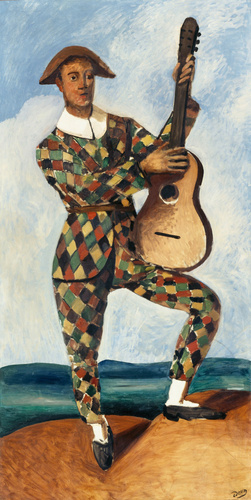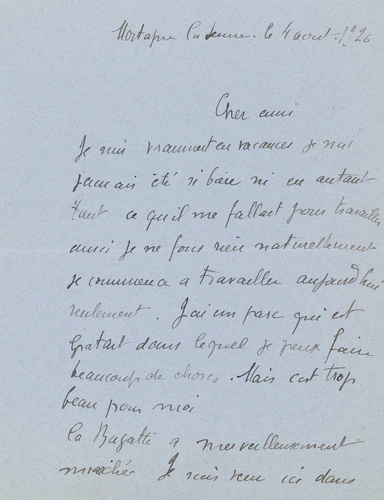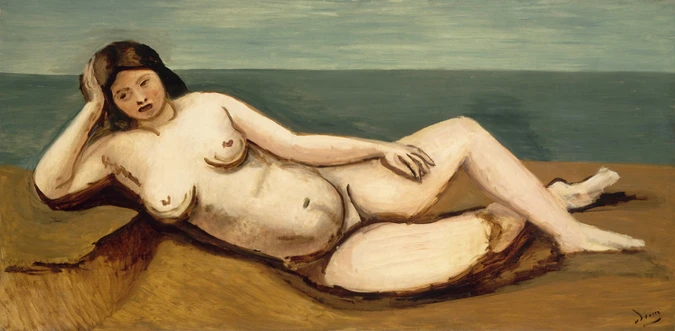Portrait de Madame Paul Guillaume au grand chapeau


This portrait of Madame Paul Guillaume, who would later become Madame Jean Walter, is without doubt a true likeness. Domenica appears as a woman of the world, wearing an elegant hat and an elegantly draped stole. Her carefully made-up face looks severe, and her eyes, whose pupils Derain emphasised with a touch of white, seem to look directly at the viewer. The painter succeeded in seeing right into the mind of this woman, who, after the death of Paul Guillaume, revealed herself to be greedy and unscrupulous, manipulating husband and lovers, prepared to do anything to retain her status and her fortune. Derain’s portrait has become symbol of the "diabolical" Domenica.
In the background, a red curtain evokes a richly furnished interior. On the right, we can make out a faint sketch of Pierrot et Arlequin, the great painting that Paul Guillaume had commissioned from Derain. But is it really the great painting itself or one of the two sketches that the couple also hung in their apartments? Whatever the case, this was a way for Derain to highlight the special relationship he had with the dealer.
The portrait of Domenica had pride of place in Paul Guillaume’s room, in the Avenue du Bois, which became the Avenue Foch in 1929 (Paris).
Provenance: Paul Guillaume en 1929; Domenica Walter
- à partir de 1929, dans la collection Paul Guillaume, Paris
- jusqu'en 1959, dans la collection de Mme Jean Walter, Paris
- 1959, acquis de Mme Jean Walter avec le concours de la Société des Amis du Louvre (arrêté d'approbation de la vente du 21/02/1959)
- musée du Louvre, Paris
- musée de l'Orangerie, Paris
- Collection particulière de M. Paul Guillaume - galerie Bernheim-Jeune - France, Paris, 1929-1905
- Collection Jean Walter-Paul Guillaume - musée de l'Orangerie - France, Paris, 1966
- Hommage à André Derain (1880-1954) - musée d'Art moderne de la Ville de Paris - France, Paris, 1980-1981
- André Derain : le peintre du "trouble moderne" - musée national d'art moderne - France, Paris, 1994-1995
- Chefs-d'oeuvres du musée de l'Orangerie : collection Jean Walter et Paul Guillaume - Bunkamura Museum of Art - Japon, Tokyo, 1998-1999
- Chefs-d'oeuvres du musée de l'Orangerie : collection Jean Walter et Paul Guillaume - City Art Museum - Japon, Nagoya, 1999
- Chefs-d'oeuvres du musée de l'Orangerie : collection Jean Walter et Paul Guillaume - Prefectural Art Museum - Japon, Hiroshima, 1999
- Chefs-d'oeuvres du musée de l'Orangerie : collection Jean Walter et Paul Guillaume - Niigata City Art Museum - Japon, Niigata, 1999
- Chefs-d'oeuvres du musée de l'Orangerie : collection Jean Walter et Paul Guillaume - National Museum of Modern Art - Japon, Kyoto, 1999
- Chefs-d'oeuvre du musée de l'Orangerie : collection Jean Walter et Paul Guillaume - Taïpei Fine Arts Museum - Taïwan, Province de Chine, Taïpei, 1999-2000
- Chefs-d'oeuvre du musée de l'Orangerie : collection Jean Walter et Paul Guillaume - Kaohsiung Museum of Fine Arts - Taïwan, Province de Chine, Kaohsiung, 2000
- De Renoir à Picasso : chefs-d'oeuvre du musée de l'Orangerie - musée des beaux-arts - Canada, Montréal, 2000
- De Renoir à Picasso : chefs-d'oeuvre du musée de l'Orangerie - Kimbell Art Museum - Etats-Unis, Fort Worth, 2000-2001
- Renoir to Picasso : Masterpieces from the Musée de l'Orangerie - Queensland Art Gallery - Australie, Brisbane, 2001
- Renoir to Picasso : Masterpieces from the Musée de l'Orangerie - Art Gallery of New South Wales - Australie, Sydney, 2001
- Renoir to Picasso : Masterpieces from the Musée de l'Orangerie - National Gallery of Victoria - Australie, Melbourne, 2001
- De Renoir a Picasso : Obres mestres del Musée de l'Orangerie, Paris - CaixaForum - Espagne, Barcelone, 2002
-
Anonyme, Album, [s.n.], *vu [crayon] *710 [crayon] Portrait de madame Paul Guillaume en 1929 0.92 x 0.73 Exposition Collection Paul Guillaume, mai 1929 Reproduit Waldemar George, p.1
-
Walter, Domenica, Classeur Domenica Walter, [s.n.], Fol. 6 recto 72 Madame Paul Guillaume au chapeau 73 x 91 LOU avec point bleu souligné en vert Photo collée
-
Walter, Domenica, Classeur, [s.n.], Fol. 6 recto 72 Madame Paul Guillaume au chapeau 73 x 91 LOU avec point bleu souligné en vert Photo collée 3 [barré]
-
Basler, Adolphe, L' Amour de l'art, M. Paul Guillaume et sa collection de tableaux, [s.n.], 1929, repr. p. 252 ["Portrait de Madame P. Guillaume", "Collect. P. Guillaume"]
-
George, Waldemar, La Renaissance, La grande peinture contemporaine à la collection Paul Guillaume, [s.n.], 1929, p. 181-182 ["Portrait de Mme Paul Guillaume", "collection Paul Guillaume"]
-
George, Waldemar, La Grande Peinture contemporaine à la collection Paul Guillaume, Paris, Ed. des Arts à Paris, 1929, p. 106, repr. p. 107 ["Portrait de Mme Paul Guillaume", "collection Paul Guillaume"]
-
Basler, Adolphe, Derain, Paris, G. Crès, 1931, n° 27, repr. pl. 27 ["Portrait de Mme Paul Guillaume", "Collection Paul Guillaume"]
-
Heilmaier, Hans, Deutsche Kunst und Decoration, Die Sammlung Paul Guillaume, [s.n.], 1931, p. 269, repr. p. 264 ["Bildnis Mme. Guillaume", "Paul Guillaume"]
-
Brielle, Roger, L' Art et les artistes, André Derain, peintre classique, [s.n.], 1934, repr. ["Portrait de Mme Paul Guillaume", "Collection Paul Guillaume"]
-
George, Waldemar, La Renaissance, n°34, L' art français et l’esprit de suite,, [s.n.], 1937, s.n., [p. 29], repr. ["Portrait de Mme Paul Guillaume [détail]", "Collection Mme Paul Guillaume"]
-
Collection Jean Walter-Paul Guillaume, Paris, Réunion des musées nationaux, 1966, n° 79, repr. n. p.
-
Cachin, Françoise, Art News, A Dandy at the Helm, [s.n.], 1966, mentionné p. 36, repr.
-
Lemoyne de Forges, Marie-Thérèse ; Allemand, Geneviève ; Bundorf, Michèle, Collection Jean Walter-Paul-Guillaume : catalogue, Paris, Réunion des musées nationaux, 1966, n° 79, p. 167, repr. p. 166
-
Rheims, Maurice, Elle, Les secrets de la fabuleuse collection qu’elle donne au Louvre, [s.n.], 1966, mentionné p. 61, repr.
-
Van Gindertael, Roger, Modigliani et Montparnasse, Paris, Editions Tête de feuille, 1976, mentionné p. 12,15, repr. coul. pl. p. 72 (Portrait de Mme Paul Guillaume)
-
Fagiolo Dell'Arco, Maurizio, L' Opera completa di De Chirico 1908-1924, Rome, Rizzoli, 1984, s.n., [p. 29], repr. ["Portrait de Mme Paul Guillaume [détail]", "Collection Mme Paul Guillaume"]
-
Preston, Stuart, Burlington Magazine, "The reopening of l’Orangerie, [s.n.], 1984, p. 590, repr. p. 595 fig. 63
-
Perl, Jed, Paris Without End, San Francisco, North Point Press, 1988, p. 21
-
Cabanne, Pierre, André Derain ,réédité en 1994 chez Gallimard coll. Folio essais, Paris, Somogy, 1990, mentionné p. 77, 142, repr. coul. p. 77
-
Hoog, Michel ; Guicharnaud, Hélène ; Giraudon, Colette, Musée de l’Orangerie : catalogue de la collection Jean Walter et Paul Guillaume, 3ème éd. revue et mise à jour [1ère éd. 1984], Paris, Réunion des musées nationaux, 1990, n° 31, p. 76, repr. coul. p. 77
-
Lucie-Smith, Edward, Art Deco Painting, Oxford, Phaidon, 1990, p. 64, repr. coul. pl. 42, p. [66]
-
Diehl, Gaston, Derain, Paris, Flammarion, 1991, p. 61 et mentionné p. 96, repr. coul. p. de couv. et p.61
-
Kellermann, Michel, André Derain : catalogue raisonné de l'oeuvre peint, Paris, Galerie Schmit, 1992, n° 1152, t. II (1915-1934), p. 215, repr. coul. p. 198 ["Portrait de Madame Paul Guillaume au grand chapeau", "Paul Guillaume (Paris) Mme Jean Walter (Paris) Mu
-
Giraudon, Colette, Paul Guillaume et les peintres du XXe siècle : de l’art nègre à l’avant-garde, Paris, La Bibliothèque des arts, 1993, mentionné p. 57, repr. coul. p. 56
-
Bachelard, Patrice, Derain, un fauve pas ordinaire, Paris, Gallimard, 1994, p. 68 et mentionné p. 122, repr. coul. (Mme Paul Guillaume au grand chapeau)
-
Trystram, Flora, La Dame au grand chapeau, Paris, Flammarion, 1996, repr. coul. p. de couv
-
Georgel, Pierre ; Peng, Chang-Ming, Chefs-d'oeuvre du musée de l'Orangerie : collection Jean Walter et Paul Guillaume., Taïpei, China Times, 1999, n° 54, p. 158, repr. coul. 159
-
Saint-Pierre, Isaure de, Version Fémina (Sud Ouest Dimanche) , n° 68, "Domenica Walter-Guillaume dangereusement belle, [s.n.], 2003, p. 24-27, repr. coul. p. 25
-
Von der Weid, Jean-Noël, Musée de l’Orangerie : guide de visite, Artlys, 2006, mentionné p. 71, repr. coul. 71 et 66
-
Wat, Pierre ; Lesage, Caroline ; Dufour, Philippe, Beaux Arts Magazine, "Le Musée de l’Orangerie", [s.n.], 2006, mentionné p. [35], repr. coul. p. [34]
-
Monod-Fontaine, Isabelle, Cahiers André Derain, n°9, Le peintre et ses modèles, [s.n.], 2008, p. 8, repr. coul. p. 9
-
Vial, Marie-Paule ; Vial, Marie-Paule, Derain, Paris Paris, Skira Flammarion, 2012, p. 4, repr. coul. p. 5, 33, mentionné p. 32
-
Collection particulière de M. Paul Guillaume, cat. exp. (Paris, Bernheim-Jeune, 1929), [s.n.], 1929, s.n. (sans cat.)
-
Cent portraits de femmes, cat. exp. (Paris, Charpentier, 1950), [s.n.], 1950, n° 28 (cat. n.p., repr. ["Mme Paul Guillaume"])
-
Hommage à André Derain (1880-1954), cat. exp. (Paris, MAMVP, 1980-1981), Paris, [s.n.], 1980, s.n. (cat. p. 37, repr. p. 37)
-
Lee, Jane, Derain, cat. exp. (Oxford ; Édimbourg ; Troyes, 1990-1991), Paris, Phaidon, 1990, p. 71 et mentionné p. 122, repr. coul. pl. 47 p.70
-
Pagé, Suzanne, André Derain : le peintre du "trouble moderne", cat. exp. (Paris, MAMVP, 1994-1995), [s.n.], 1994, n° 143
-
Pagé, Suzanne ; Llorens, Tomas ; Marquet, Françoise, André Derain : le peintre du “trouble moderne”, cat. exp. (Paris, musée d'art moderne de la Ville de Paris, 1994-1995), Paris, Paris-Musées, 1994, n° 143, p. 482, repr. coul. p. 416, mentionné p. 232
-
Georgel, Pierre ; Kijima, Shunsuke ; Nagai, Takanori, Chefs-d'oeuvre du musée de l'Orangerie : collection Jean Walter et Paul Guillaume, cat. exp. (Tokyo ; Nagoya ; Hiroshima ; Niigata ; Kyoto, 1998-1999), Tokyo, NTV, 1998, n° 54, p. 132, 211, repr. coul. p. [133]
-
Georgel, Pierre ; Labiau, Jean-Pierre, De Renoir à Picasso : chefs d'oeuvre du musée de l'Orangerie, cat. exp. (Montréal ; Fort Worth, 2000-2001), Montréal, Musée des Beaux-Arts, 2000, n° 73, p. 252, repr. coul. p. 253
-
Daguerre de Hureaux, Alain, Cézanne : quatorze chefs-d’oeuvre du musée de l’Orangerie, cat. exp. (Toulouse, Musée des Augustins, 2003-2004), Toulouse, Musée des Augustins, 2003, repr. coul. p. 14
-
Bréon, Emmanuel, Les enfants modèles : de Claude Renoir à Pierre Arditi, cat. exp. (Paris, Musée de l'Orangerie, 2009), Paris, Réunion des musées nationaux, 2009, mentionné p. 25
-
Chefs-d'oeuvre du Musée de l'Orangerie, collection Jean Walter et Paul Guillaume, cat. exp. (Yokohama Museum of Art, 21 septembre 2019-13 janvier 2020), Yokohama, Yokohama, Yokohama Museum of Art, 2019, n° 46, 111, ill.. en coul.
Do you have a question where you have additional knowledge about this work? You can write to us to suggest improvements to the file.
Make a suggestion






